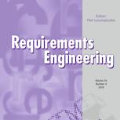Capturing users' engagement is crucial for gathering feedback about the features of a software product. In a market-driven context, current approaches to collect and analyze users' feedback are based on techniques leveraging information extracted from product reviews and social media. These approaches are hardly applicable in bespoke software development, or in contexts in which one needs to gather information from specific users. In such cases, companies need to resort to face-to-face interviews to get feedback on their products. In this paper, we propose to utilize biometric data, in terms of physiological and voice features, to complement interviews with information about the engagement of the user on the discussed product-relevant topics. We evaluate our approach by interviewing users while gathering their physiological data (i.e., biofeedback) using an Empatica E4 wristband, and capturing their voice through the default audio-recorder of a common laptop. Our results show that we can predict users' engagement by training supervised machine learning algorithms on biometric data (F1=0.72), and that voice features alone are sufficiently effective (F1=0.71). Our work contributes with one the first studies in requirements engineering in which biometrics are used to identify emotions. This is also the first study in software engineering that considers voice analysis. The usage of voice features could be particularly helpful for emotion-aware requirements elicitation in remote communication, either performed by human analysts or voice-based chatbots, and can also be exploited to support the analysis of meetings in software engineering research.
翻译:在市场驱动的背景下,目前收集和分析用户反馈的方法是基于利用产品审查和社交媒体获得的信息的技术。这些方法很难适用于口述软件开发,或具体用户需要收集信息的情况。在这种情况下,公司需要面对面的访谈,以获得产品反馈。在本文件中,我们提议利用生物鉴别数据,即生理和声音特征的数据,以用户参与讨论讨论的产品相关专题的信息作为访谈的补充。我们评估了我们的方法,在使用Empatica E4手腕带收集其生理数据(即生物回馈)时,利用Empatica E4手腕带收集其数据,通过默认的音频调调收集其声音。在这类情况下,公司需要利用面对面的访谈来获得关于其产品的反馈。在本文中,我们提议利用生物鉴别数据监督的机器学习算法(F1=0.72)来预测用户的参与情况,而仅使用语音特征是足够有效的(F1=0.71),我们的工作是对用户进行首次研究的方法,在其中首次对用户进行访问,利用生物鉴别会议进行生理特征分析时,这种分析也可以通过远程分析来分析。





